#007: Omphalotus illudens, The Jack-O-Lantern Mushroom
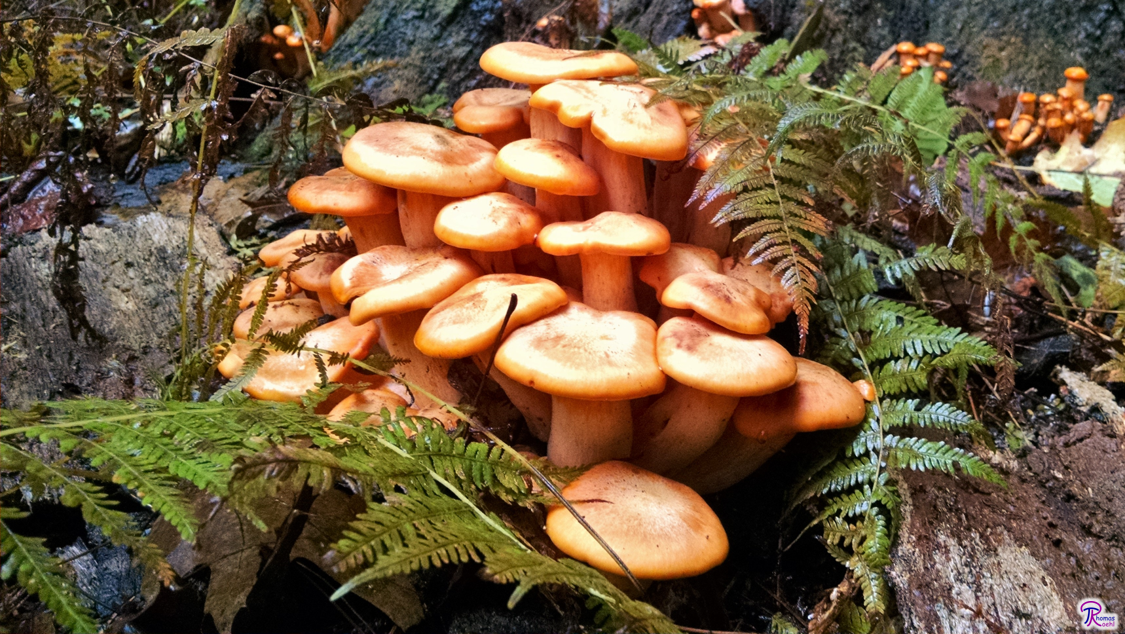
Omphalotus illudens, the Jack-O-Lantern mushroom, is characterized by its bright orange color, its growth on wood, and its decurrent, non-forking gills. Typical of the species, this cluster is growing right next to a tree stump.
If the spirit of Halloween were a mushroom, it would be Omphalotus illudens. This agaric is commonly known as the “Jack-O-Lantern mushroom” for a few good reasons. First, it is bright orange, like the pumpkins that decorate doorsteps all over the United States in October. Not only is the cap orange, but so are the gills, the stipe, and the interior. Second, the mushroom’s gills glow in the dark, especially when they are young and fresh. Furthermore, the mushroom often has a sweet smell and is poisonous. Nothing says Halloween like something that is orange, glows in the dark, smells sweet, and has a sinister side.1–4
Description
The first thing you notice about the Jack-O-Lantern mushroom is its color; the mushroom is strikingly orange, about the color of a ripe orange or pumpkin.1–3 This color is very intense and can stain your fingers orange when you handle the mushroom. O. illudens fruits in dense clusters that easily grow as big as a basketball or medium-sized pumpkin. The individual mushrooms are umbrella-shaped agarics and grow 3-20cm tall and 3-20cm across. Thanks to its size and color, O. illudens is one of the easiest mushrooms to spot in the woods.1–3
When young, the Jack-O-Lantern’s pileus is convex and inrolled, making the mushroom look more lollipop-shaped than umbrella-shaped. The pileus flattens out as it expands and eventually becomes upturned with a central depression in age. Although the pileus starts out fairly uniform, the margin usually becomes somewhat lobed and wavy as it gets older. Throughout development, the cap usually has a small pointy bump at the center (mycologists call this an “umbo”). The rest of the cap is smooth and bright orange to yellow-orange.1–3
The gills of the Jack-O-Lantern run down the stipe and are about the same color as the cap. Importantly, the gills do not fork; this helps distinguish it from some of the mushroom’s look-alikes. The gills produce spores, which deposit a whitish to pale yellowish spore print.1–3
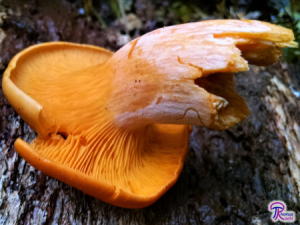
The Jack-O-Lantern mushroom has gills that run down the stipe and do not fork. Its stipe is also typically lighter than the cap, gills, and interior flesh.
O. illudens’s stipe is also smooth and orange, but is usually paler than the gills and cap. The Jack-O-Lantern’s stipe is unusually thick for a mushroom, regularly reaching 1-2cm in diameter. It gets thinner and darker toward the base, where it squeezes together with the stipes from other mushrooms in the cluster. The flesh inside the mushroom is usually a darker shade of orange than the stipe, so injuries on the stipe are easily visible.1–3
The mushrooms may have no odor or may have a pleasant odor1,3 (to me, they usually smell sweet and somewhat fruity). Sometimes this pleasant odor is so strong that it becomes somewhat unpleasant. Despite its appealing smell, O. illudens does not taste like much (please, don’t taste this mushroom).1,3
The most interesting thing about the Jack-O-Lantern mushroom is that it glows in the dark! This bioluminescence is primarily concentrated on the mushroom’s gills. If you want to see why O. illudens is named the Jack-O-Lantern, find some young and fresh mushrooms (a large cluster with mostly lollipop-shaped caps will work best) and sit in a dark room until your eyes adjust (this can take half an hour or more, so be patient). If you’re lucky, you should start to see a greenish glow coming from the gills. O. illudens’s bioluminescence is apparently widely variable. Some people report finding clusters that glowed bright enough to use as a torch in the dark woods while other people have never seen the mushroom glow.1,4 Some of this variation may be due to personal sensitivities; I find it is easier for some people to see the glow than it is for others.
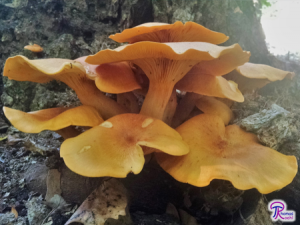
O. illudens can grow directly from wood, but you more often see it growing from the ground right next to a tree stump. This older cluster is developing a wavy margin and depressed center, as do most aging specimens.
Ecology
The Jack-O-Lantern decays the bases and roots of hardwoods. It seems to prefer stumps rather than logs for some reason. The mushroom can fruit directly from the stump, but more often than not it appears on the ground right next to the stump. You can find O. illudens from summer through fall in North America east of the Rocky Mountains and in Europe.1–3
Similar species
There are actually at least two species of Omphalotus present in North America: O. olivascens and O. illudens. O. olivascens is found west of the Rocky Mountans and has more greenish tones. Thanks to the geographical separation, it is easily distinguished from O. illudens.1 There may be a third species in North America: O. subilludens. That mushroom grows in the southern United Sates and is indistinguishable from O. illudens without microscopic analysis.[note]
In Europe, the species O. olearius can be confused with O. illudens. You can distinguish O. olearius by its more brownish cap and its preference for olive trees (olearius is derived from the genus of olive trees, Olea).2,5,6 If you still can’t tell the difference, you’ll have to rely on microscopic characteristics.
It is very easy to confuse O. illudens with golden chanterelles (FFF#101). Both are orange, grow from the ground, and smell nice. However, you can quickly differentiate between the two by checking a few features. O. illudens grows on wood but can appear terrestrial, so if the mushrooms are centered around a dead tree or are growing right at the base of a tree, they are probably the Jack-O-Lantern. Chanterelles are mycorrhizal, so they are always terrestrial. O. illudens has true gills, whereas chanterelles have false gills which are more like folds or ridges that run down the stipe (this distinction becomes more obvious when you have found both species). The Jack-O-Lantern mushroom tends to fruit in dense clusters while chanterelles tend to have individual fruiting bodies scattered around an area.2,4 And of course, chanterelles do not glow in the dark. The best way to understand the differences between the two is to learn from an experienced mushroom hunter. Even I thought O. illudens was a chanterelle the first time I saw it. Fortunately, there was an expert on hand to tell me otherwise.
Hygrophoropsis aurantiaca (FFF#196) is another orange mushroom that grows from wood. The easiest way to differentiate this mushroom from O. illudens is by looking it its gills. H. aurantiaca has gills that fork repeatedly, while the Jack-O-Lantern has gills that do not fork.2 I have found a couple forked gills in O. illudens, but that doesn’t compare to the repeatedly and frequently forking gills of H. aurantiaca.
Honey mushrooms are similar to O. illudens in growth habit; both species grow in dense clusters at the bases of trees. Fortunately, all honey mushrooms are some shade of brown to yellow so you can’t mistake them for the brilliantly orange Jack-O-Lantern mushroom.
I once heard of someone who mistook O. illudens for Chicken of the Woods (Laetiporus sulphureus, FFF#102). Chicken of the Woods has bright yellow pores underneath its orange pileus, is attached wood laterally, has thicker and more bumpy flesh, and smells completely different. I don’t understand how you can confuse the two unless all you had to go on were two blurry photographs.
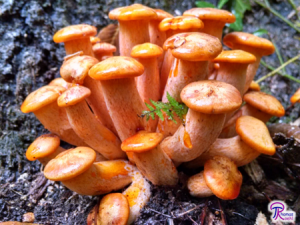
This young cluster of O. illudens would probably glow very well. Note how thick the stipes are compared to the caps at this stage. Not many mushrooms display that characteristic.
Edibility
Although O. illudens looks attractive and smells pleasant, do not eat it! The Jack-O-Lantern contains the toxin muscarine (see FFF#094) and causes a variety of unpleasant symptoms. Most people will experience severe abdominal cramps, vomiting, and diarrhea.3,4 Additionally, muscarine can cause sweating, salivation, decreased blood pressure, irregular heartbeat, breathing difficulties, and visual distortions.7 The gastrointestinal distress caused by O. illudens can last several days, but – fortunately – the mushroom is rarely fatal.3,4
Taxonomy
As with many fungi, there is some confusion as to whether or not the North American and European varieties are the same species.4,5 Research from the early 2000’s appears to have pushed the debate in favor of separating O. illudens and O. olearius, although the matter has not been definitively settled.5,8,9
Omphalotus translates to “like a belly button” and refers to the tendency of O. illudens to have a pileus that is depressed in the center when mature. Illudens translates to “deceiving” and presumably refers to the mushroom’s similarity to the European species O. olearius.2,3
| Kingdom | Fungi |
| Division (Phylum) | Basidiomycota |
| Subdivision (Subphylum) | Agaricomycotina |
| Class | Agaricomycetes |
| Subclass | Agaricomycetidae |
| Order | Agaricales |
| Family | Omphalotaceae |
| Genus | Omphalotus |
| Species | Omphalotus illudens (Schwein.) Bresinsky & Besl8 |
See Further:
http://www.mushroomexpert.com/omphalotus_illudens.html
http://botit.botany.wisc.edu/toms_fungi/oct97.html
http://www.first-nature.com/fungi/omphalotus-illudens.php
https://www.messiah.edu/Oakes/fungi_on_wood/gilled%20fungi/species%20pages/Omphalotus%20illudens.htm
Citations
- Kuo, M. Omphalotus illudens. MushroomExpert.Com (2015). Available at: http://www.mushroomexpert.com/omphalotus_illudens.html. (Accessed: 26th October 2017)
- Emberger, G. Omphalotus illudens. Fungi Growing on Wood (2008). Available at: https://www.messiah.edu/Oakes/fungi_on_wood/gilled%20fungi/species%20pages/Omphalotus%20illudens.htm. (Accessed: 26th October 2017)
- O’Reilly, P. Omphalotus illudens (Schwein.) Bresinsky & Besl – Jack o’ Lantern. First Nature Available at: http://www.first-nature.com/fungi/omphalotus-illudens.php. (Accessed: 26th October 2017)
- Volk, T. J. Tom Volk’s Fungus of the Month for October 1997. Tom Volk’s Fungi (1997). Available at: http://botit.botany.wisc.edu/toms_fungi/oct97.html. (Accessed: 26th October 2017)
- Kuo, M. Omphalotus olearius. MushroomExpert.Com (2015). Available at: http://www.mushroomexpert.com/omphalotus_olearius.html. (Accessed: 26th October 2017)
- Olive. Wikipedia (2017).
- Mushroom Poisoning Syndromes. North American Mycological Association Available at: https://www.namyco.org/mushroom_poisoning_syndromes.php. (Accessed: 26th October 2017)
- Omphalotus illudens. Mycobank Available at: http://www.mycobank.org/name/Omphalotus%20illudens&Lang=Eng. (Accessed: 26th October 2017)
- Species Fungorum – Species synonymy – Omphalotus illudens (Schwein.) Bresinsky & Besl, Beih. Sydowia 8: 106 (1979). Species Fungorum Available at: http://www.speciesfungorum.org/Names/SynSpecies.asp?RecordID=318990. (Accessed: 26th October 2017)

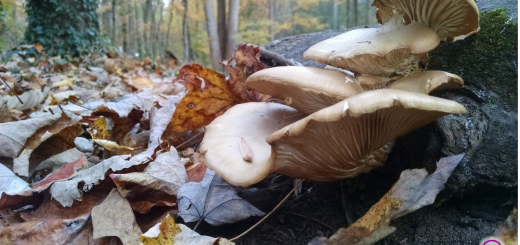






![#011: Characteristics of Kingdom Fungi [Archived]](https://www.fungusfactfriday.com/wp-content/themes/hueman/assets/front/img/thumb-small-empty.png)

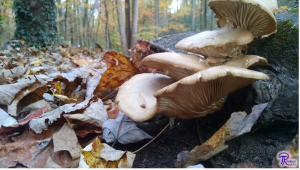
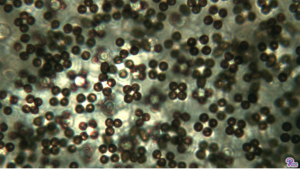
1 Response
[…] Source: #007: Omphalotus illudens, the “Jack-O-Lantern mushroom” – Fungus Fact Friday […]